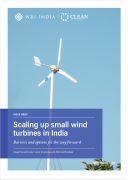Scaling up small wind turbines in India: Barriers and options for the way forward
by , and -Small wind turbines (SWTs) are an adaptable and flexible option for the generation of renewable electricity. They can be sited at locations with a reasonable wind resource that are unsuitable for large wind projects. SWTs, whether operating individually or as hybrids, are also classified as distributed renewable energy generation (DREG) systems. Hence, in addition to improving the utilization of wind and expanding renewable capacity in line with the 2030 500 GW targets (PIB Delhi 2021), SWTs can also support the Indian government’s plans to promote DREG for livelihood applications and contribute toward distributed renewable purchase obligation (RPO) targets.
As of January 2024, India had a cumulative capacity of over 44 GW of large onshore wind installations, behind China, the United States, and Germany, which had 441, 148, and 69 GW, respectively (IRENA 2024). However, the installed capacity of SWTs and small wind–solar hybrid systems in India is only about 3.3–5 MW (MNRE 2019), in contrast to China and the United States, which have installed capacities of 704 MW and 156 MW, respectively (US DOE 2023). Wind-rich states such as Tamil Nadu, Gujarat, and Karnataka, which have large utility-scale wind farms and considerable experience in implementing wind power projects, do not have a proportional number of small wind installations. The installed capacity of small wind systems in Tamil Nadu is only about 257 kW, and the situation in other wind-rich states is similar (e.g., Gujarat 20 kW, Karnataka 39 kW) (MNRE 2019).
Multiple reasons hinder the growth of SWTs in India and limit scale-up of the technology. The potential for SWTs in India is quite large. Although an accurate figure is not available, the World Institute of Sustainable Energy estimates the potential at about 83 GW (WISE 2009), and Kumar et al. (2022) estimate the potential for SWTs in the state of Tamil Nadu alone to be nearly 4 GW. An in-depth understanding of the issues preventing SWT scale-up is necessary. Examining some interventions that could mitigate or overcome these barriers could prove to be a useful exercise.
This issue brief provides insights into the barriers that prevent large-scale adoption of SWTs in India and describes the interventions that are likely to mitigate or overcome these barriers. The paper first sets the stage with an overview of the current landscape of SWTs in India and their applications, using literature surveys, stakeholder consultations, and roundtable discussions to achieve these goals.


